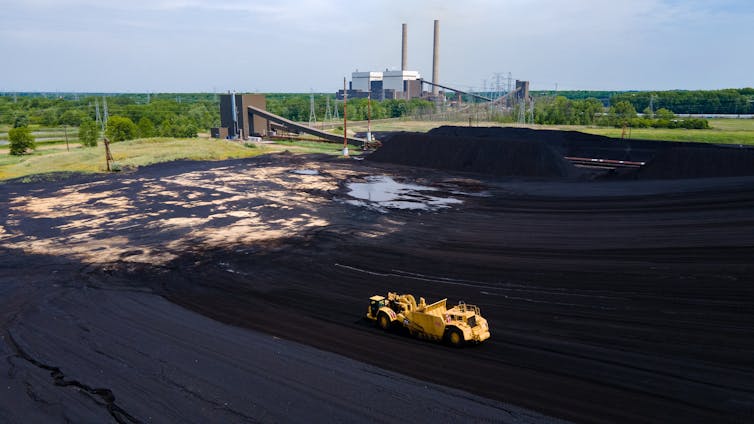Climate crisis: what Trump can (and can’t) do
Donald Trump will return to lead the world’s largest historical emitter of greenhouse gas.
Neither Trump nor Kamala Harris made the climate crisis a prominent feature of their campaigns, during an election cycle in which America was pounded by weather disasters. Hurricane Helene, which struck in late September was supercharged by an abnormally hot Atlantic Ocean and killed 232 people across the south-eastern US.
Nearly half of those deaths occurred in the swing state of North Carolina, which moved decisively behind Trump. Voters in the state’s still devastated west lacked polling stations yesterday and cast their ballots in tents.
Scientists say the Earth system is balanced on a knife edge: the carbon-rich Amazon rainforest is drying out, a North Atlantic current that redistributes ocean heat is slowing down. If either collapses, it would tip the climate into deeper chaos.
Drill, baby, drill?
Democrats lost in America’s former manufacturing heartland, the midwestern states that now comprise the “Rust Belt” and the party’s erstwhile “Blue Wall”. A river choked with industrial waste caught fire here in 1969 and prompted a wave of federal regulation that culminated in the founding of the Environmental Protection Agency (EPA) by the Nixon administration. The EPA regulates climate pollution with rules that limit emissions from power plants and vehicles, two of the country’s biggest CO₂ sources.

“The policy proposals outlined by Donald Trump and the thinktanks advising his campaign would turn back the tide on America’s bedrock environmental laws,” say environmental policy experts Stephen Lezak (University of Oxford) and Barbara Haya (University of California, Berkeley).
According to a rightwing manifesto attached to the Trump campaign (though not formally endorsed by Trump himself), that could include “a whole-of-government unwinding” in which the EPA’s “structure and mission [are] greatly circumscribed”.
“Trump has promised to fire experts in government, install loyalists in their place, and adopt a ‘drill, baby, drill’ mentality,” say Lezak and Haya.
If he chooses to enact the Project 2025 manifesto, as it’s known, Trump would also cut funding for emergency preparedness and so risk lives unnecessarily during mounting disasters.
He would also “dismantle” and “privatise” much of the National Oceanic and Atmospheric Administration (NOAA), a government agency that has studied the weather, monitored the ocean and managed the protection of endangered species since 1970.
Trump’s possible plans for NOAA indicate his wider climate agenda according to David Hastings Dunn, a professor of international politics at the University of Birmingham who has studied Project 2025.
“NOAA is described as ‘one of the main drivers of the climate change alarm industry’, and the ideological response is to abolish the scientific body that produces evidence that substantiates the impact of climate change,” he says.
IRAte
Trump could choose to scrap or fatally undermine the 2015 Paris agreement and the 2022 Inflation Reduction Act (IRA).
In his first term, Trump took America out of the Paris agreement, which committed countries to limiting global warming to well below 2°C. Climate scientist Mark Maslin (UCL) worries that a second US exit – or a full withdrawal from the UN climate negotiations themselves (another round starts next week in Azerbaijan) – could spur an international race to the bottom.
“Pulling out one of the world superpowers from negotiations to reduce global greenhouse gas emissions is a big deal as it allows other countries to slow their own decarbonisation and blame the US instead of their own lack of ambition,” he says via email.

Hailed as the greatest climate achievement of the Biden White House, IRA extended subsidies for building renewable energy until 2032. These subsidies generally take the form of federal tax breaks for investors in wind and solar farms. The biggest beneficiary? Banks, according to research by Durham University geographer Sarah Knuth.
“Renewable tax credits were never intended as a backdoor subsidy for Wall Street. Yet they now provide major tax shelters for banks; ones that need highly complex partnership forms to be legal at all,” she says.
This is not the only way to fund the green transition says Knuth, and Democrats may regret championing such an imperfect model for nurturing green energy.
“Even the biggest banks only have so many tax dollars to shelter, and fast-growing renewable power increasingly demands more capital than tax equity investors can provide,” she says.
“Major corporate tax cuts, like the one introduced under President Trump, can unexpectedly shrink the entire market.”
Maslin notes Trump’s vocal support for coal, the dirtiest fossil fuel, but he says he is buoyed by the strength of America’s green industries, and “simple economics”.
“Trump may slow down the transition away from fossil fuels and allow other countries to delay action – but the writing is on the wall both politically and economically for fossil fuels,” he says.
“It is when not if fossil fuel ceases to be used as an energy source.”

